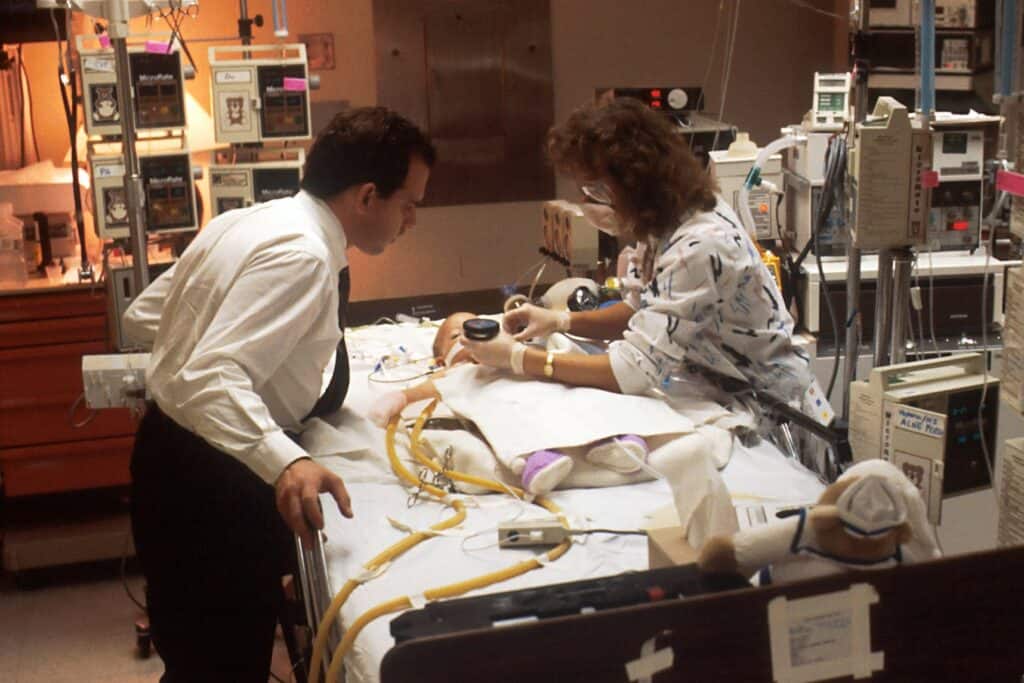Babies choking on milk is a common problem that can be scary for both the baby and their caretaker. Choking occurs when food or liquid gets stuck in the baby’s airway, making it difficult for them to breathe. It is important for caretakers to understand the causes of choking and how to recognize the signs in order to respond immediately and prevent further harm.
Understanding Babies Choking on Milk Babies choking on milk can happen for a variety of reasons, including improper feeding techniques, developmental delays, and medical conditions. When a baby is feeding, milk can enter the airway instead of the stomach, leading to choking. This can happen if the baby is not properly positioned during feeding or if the flow of milk is too fast. Developmental delays or medical conditions that affect the muscles used for swallowing and breathing can also increase the risk of choking.
Key Takeaways
- Choking can occur when milk enters a baby’s airway instead of their stomach during feeding.
- Improper feeding techniques, developmental delays, and medical conditions can increase the risk of choking.
- Caretakers should understand the causes of choking, recognize the signs, respond immediately, and take steps to prevent choking from occurring.
Understanding Babies Choking on Milk
Babies choking on milk is a common concern for parents, especially those with newborns. Choking on milk can happen while breastfeeding or bottle-feeding, and it can be a scary experience for both the baby and the caregiver. Understanding why babies choke on milk and how to prevent it can help parents feel more confident and keep their babies safe.

Causes of Babies Choking on Milk
There are several reasons why babies may choke on milk. Some of the common causes include:
- Overactive letdown: This occurs when the milk comes out too quickly and forcefully, making it difficult for the baby to keep up with swallowing. This can cause the baby to gag or choke.
- Poor latch: If the baby is not latched onto the breast or bottle correctly, they may not be able to get enough milk or may take in too much air while feeding, leading to choking.
- Reflux: Babies with reflux may have a harder time swallowing and keeping milk down, which can lead to choking.
- Teething: When babies are teething, they may be more likely to chew on the nipple or bottle, which can cause them to take in too much milk at once and choke.
Signs of Babies Choking on Milk
It’s important for parents to recognize the signs of babies choking on milk so they can take action quickly. Some of the signs include:
- Coughing or gagging during or after feeding
- Difficulty breathing or turning blue
- Arching their back or becoming stiff
- Refusing to feed or pulling away from the breast or bottle
Prevention of Babies Choking on Milk
There are several things parents can do to prevent babies from choking on milk:
- Positioning: Positioning the baby properly during feeding can help prevent choking. The baby should be upright with their head slightly elevated.
- Burping: Burping the baby frequently during feeding can help release any trapped air and prevent choking.
- Slowing down: If the baby is having trouble keeping up with the milk flow, slowing down the feeding can help prevent choking.
- Checking the nipple: Making sure the nipple is the right size and shape for the baby can help prevent choking.
In conclusion, babies choking on milk is a common concern for parents, but understanding the causes, signs, and prevention methods can help keep babies safe and give parents peace of mind.
Causes of Choking
Babies choking on milk is a common concern among parents. It can be a scary experience for both the baby and the parent. There are several reasons why a baby may choke on milk, including:

1. Feeding Position
The position in which a baby is fed can affect their ability to swallow milk. If a baby is lying too flat, the milk can pool in the back of their throat, making it difficult to swallow. On the other hand, if a baby is positioned too upright, they may struggle to coordinate their breathing and swallowing.
2. Overactive Letdown
Overactive letdown is when milk is released from the breast too quickly. This can cause a baby to choke and sputter while feeding. It can also lead to excess air intake, which can cause discomfort and gas.
3. Oversupply of Milk
An oversupply of milk can also cause a baby to choke. When there is too much milk, it can flow too quickly, causing the baby to struggle to keep up. This can also lead to excess air intake and discomfort.
4. Hyper-Gag Reflex
Some babies have a hyper-gag reflex, which means that their gag reflex is overactive. This can cause them to gag and choke while feeding, even if there is no obstruction in their airway.
5. Gastroesophageal Reflux
Gastroesophageal reflux (GER) is a condition where stomach acid flows back into the esophagus. This can cause discomfort and pain, as well as choking and coughing. Babies with GER may also have difficulty gaining weight and may be fussy during feedings.
Overall, there are several reasons why a baby may choke on milk. It is important to be aware of these causes and take steps to prevent choking from occurring.
Recognizing Choking Signs
Babies are prone to choking on milk, which can be a scary experience for parents. It is important to recognize the signs of choking so that you can act quickly and prevent serious harm to your baby. This section will cover the three main signs of choking: gagging, coughing, and clicking sounds.

Gagging
Gagging is a reflex action that occurs when the baby’s airway is blocked. It is a natural response to try and clear the blockage by coughing or gagging. If your baby is gagging, it is a sign that they are struggling to breathe. You should act quickly to help them clear their airway.
Coughing
Coughing is another reflex action that occurs when the baby’s airway is blocked. It is a natural response to try and clear the blockage by coughing. If your baby is coughing, it is a sign that they are struggling to breathe. You should act quickly to help them clear their airway.
Clicking Sounds
Clicking sounds are a sign that your baby’s airway is partially blocked. It is important to note that not all babies make clicking sounds when they are choking, but if you hear this sound, it is a sign that your baby is struggling to breathe. You should act quickly to help them clear their airway.
In summary, recognizing the signs of choking in babies is crucial to their safety. Gagging, coughing, and clicking sounds are all signs that your baby’s airway is blocked, and you should act quickly to help them clear their airway. If you are unsure if your baby is choking, it is always better to err on the side of caution and seek medical attention immediately.
Immediate Response to Choking
If a baby is choking on milk, it is important to act quickly to prevent any harm. The immediate response to choking involves a series of steps that can help to clear the airway and restore breathing.
Back Blows
Back blows are a technique used to dislodge any objects that may be blocking the airway. To perform back blows, the baby should be placed face down on the caregiver’s lap or forearm, with the head lower than the body. The caregiver should then deliver five firm blows to the baby’s back between the shoulder blades with the palm of their hand.
Chest Thrusts
If back blows do not work, chest thrusts may be necessary. Chest thrusts involve placing the baby on their back and delivering five firm thrusts to the center of the chest with two fingers. The thrusts should be strong enough to dislodge any objects that may be blocking the airway.
Heimlich Maneuver
If back blows and chest thrusts do not work, the Heimlich maneuver may be necessary. The Heimlich maneuver involves standing behind the baby and delivering five upward thrusts to the abdomen with the heel of the hand. The thrusts should be strong enough to dislodge any objects that may be blocking the airway.
If the baby is still choking after these steps have been taken, emergency services should be called immediately by dialing 911. Caregivers should also be trained in CPR and first aid to be prepared for any emergency situations that may arise.
Preventing Choking
Babies are prone to choking while feeding on milk. It is a common problem that can be prevented with some simple measures. In this section, we will discuss the best practices to prevent choking while feeding.

Correct Feeding Position
The feeding position of the baby plays a crucial role in preventing choking. It is recommended to hold the baby in an upright position during feeding. This position ensures that the milk flows smoothly down the baby’s throat and reduces the risk of choking.
Additionally, the baby’s head should be slightly elevated to ensure that the milk flows down smoothly. The mother should also ensure that the baby’s mouth is correctly positioned on the breast or bottle nipple to ensure a good latch.
Managing Milk Oversupply
Milk oversupply can also increase the risk of choking. It is essential to manage milk oversupply to prevent choking. The mother should ensure that the baby is not overwhelmed with too much milk.
One way to manage milk oversupply is to use a breast pump to express milk before feeding. This process ensures that the milk flows smoothly and reduces the risk of choking. Additionally, the mother can use a nipple shield to control the milk flow and prevent choking.
Head and Neck Support
The baby’s head and neck support are essential in preventing choking. The mother should ensure that the baby’s head and neck are well supported during feeding. This process ensures that the baby is comfortable and relaxed during feeding.
The mother should also ensure that the baby’s head is not tilted back too far during feeding. This position can cause the milk to flow too quickly and increase the risk of choking.
In conclusion, preventing choking while feeding is essential for the baby’s health and well-being. The correct feeding position, managing milk oversupply, and head and neck support are crucial in preventing choking. Mothers should follow these best practices to ensure that their babies are safe during feeding.
Professional Help and Support
Parents should seek professional help and support if their baby is choking on milk. The following are some options that parents can consider:
Pediatrician Consultation
Pediatricians are trained medical professionals who specialize in the care of infants and children. If a baby is choking on milk, parents should consult their pediatrician immediately. The pediatrician can assess the baby’s condition and recommend appropriate treatment. In some cases, the pediatrician may refer the baby to a specialist, such as a gastroenterologist.
Lactation Consultant Services
Lactation consultants are professionals who specialize in breastfeeding support and education. If a baby is choking on milk during breastfeeding, parents should consider consulting a lactation consultant. Lactation consultants can help parents identify the cause of the problem and provide guidance on how to correct it. They can also teach parents techniques such as block feeding and hand expression to help prevent choking.
CPR Training
CPR (cardiopulmonary resuscitation) is a life-saving technique that can be used in emergencies. Parents should consider taking a CPR course to learn how to perform CPR on their baby in case of choking or other emergencies. CPR courses are offered by many organizations, including the American Red Cross and the American Heart Association.
In conclusion, parents should seek professional help and support if their baby is choking on milk. Pediatricians, lactation consultants, and CPR training can provide parents with the knowledge and skills they need to help their baby in case of emergencies.
Post-Choking Care
Observation
After a baby chokes on milk, it is important to observe them for any signs of distress or discomfort. The following steps can be taken to ensure the baby’s safety:
- Keep the baby upright and monitor their breathing.
- Check for any signs of choking, such as coughing, gagging, or wheezing.
- Look for any changes in skin color, such as turning blue or pale.
- Observe the baby’s behavior for any signs of discomfort or distress.
If the baby appears to be in distress or is having trouble breathing, seek medical attention immediately.

Medical Follow-Up
If a baby has choked on milk, it is important to follow up with a healthcare provider to ensure that there are no underlying conditions that could lead to future choking incidents. The following steps can be taken:
- Schedule an appointment with a pediatrician or healthcare provider.
- Discuss any concerns or questions about the baby’s feeding habits, including reflux, spit-up, or mucus.
- Ask about any potential risks for aspiration or pneumonia.
- Follow any recommendations or guidelines provided by the healthcare provider.
It is important to take all necessary precautions to prevent future choking incidents, including proper feeding techniques and monitoring the baby during feedings.
Feeding Methods and Choking
When it comes to feeding babies, parents have two primary options: breastfeeding and bottle feeding. Both methods have their own advantages and disadvantages, and it is important for parents to understand the potential risks associated with each method.

Breastfeeding
Breastfeeding is a natural and healthy way to feed a baby, and it provides numerous benefits for both the baby and the mother. However, even breastfed babies can choke on milk if they are not positioned correctly during feeding or if they have an underlying medical condition that affects their ability to swallow.
To reduce the risk of choking during breastfeeding, parents should position the baby in a way that allows them to swallow and breathe comfortably. The baby’s head should be slightly elevated, and their body should be aligned with the mother’s body. It is also important to ensure that the baby is latched on correctly to prevent milk from flowing too quickly or too slowly.
Bottle Feeding
Bottle feeding is another common method of feeding babies, and it allows parents to monitor exactly how much milk their baby is consuming. However, bottle-fed babies may be at a higher risk of choking if they are not fed properly or if they are given the wrong type of bottle or nipple.
To reduce the risk of choking during bottle feeding, parents should choose a bottle and nipple that are appropriate for their baby’s age and feeding needs. It is also important to hold the baby in an upright position during feeding and to ensure that the nipple is filled with milk to prevent the baby from sucking in air.
In summary, both breastfeeding and bottle feeding can pose a risk of choking for babies if they are not fed properly or if they have an underlying medical condition. Parents should take the necessary precautions to ensure that their baby is positioned correctly during feeding and that they are using the appropriate feeding method and equipment.
Additional Information and Resources
For more information on preventing babies from choking on milk, there are several resources available. Here are a few:
- American Academy of Pediatrics (AAP): The AAP has a comprehensive guide on breastfeeding, which includes information on the letdown reflex, milk ejection reflex, and tips for positioning the baby during feeding. The guide also covers how to recognize and respond to choking and other emergencies.
- La Leche League International (LLLI): LLLI is an organization that provides support and education for breastfeeding mothers. They have a wealth of information on breastfeeding, including resources for mothers who are struggling with letdown or milk ejection reflex issues.
- The Centers for Disease Control and Prevention (CDC): The CDC has a page on their website dedicated to infant and young child feeding. The page includes information on the benefits of breastfeeding, how to breastfeed, and how to recognize and respond to choking and other emergencies.
- The World Health Organization (WHO): The WHO has a page on their website dedicated to breastfeeding. The page includes information on the benefits of breastfeeding, how to breastfeed, and how to recognize and respond to choking and other emergencies.
It’s important to note that while choking on milk can be a serious issue, it’s relatively rare. According to the AAP, only about 1 in 2,000 newborn babies will experience choking on milk. However, it’s still important for mothers to be aware of the risk and take steps to prevent it.
One way to reduce the risk of choking is to make sure the baby is in an upright position during feeding. This can help ensure that gravity helps the milk go down smoothly. Additionally, mothers can try to relax and let the milk flow naturally, rather than trying to force it out. This can help reduce the risk of choking and also help stimulate the release of oxytocin, which can help with milk letdown.
Overall, with the right information and resources, mothers can feel confident in their ability to breastfeed their babies safely and effectively.
Related post: How to Teach Your Baby to Point
Frequently Asked Questions
What should I do if my baby chokes on milk?
If your baby chokes on milk, stay calm and act quickly. First, remove the bottle or breast from your baby’s mouth. Then, hold your baby face down on your forearm and give up to five firm back blows between the shoulder blades. If the obstruction doesn’t clear, turn your baby over and give up to five chest thrusts. If your baby is still choking, call for emergency medical help.
Is it normal for babies to choke while drinking milk?
It is common for babies to gag or cough while drinking milk, especially if they are drinking too fast or the milk is too cold. However, if your baby frequently chokes or has difficulty breathing while drinking milk, it may be a sign of a more serious problem. Talk to your pediatrician if you have concerns.
When should I worry about my baby choking on milk?
You should be concerned if your baby regularly chokes or gags while drinking milk, has difficulty breathing, turns blue or becomes limp. These may be signs of a more serious problem and you should seek medical attention immediately.
What are the 4 steps of treating a choking infant?
The American Academy of Pediatrics recommends the following 4 steps for treating a choking infant under 1 year of age:
1. Hold the infant face down on your forearm and give up to five firm back blows between the shoulder blades.
2. If the obstruction doesn’t clear, turn the infant over and give up to five chest thrusts.
3. If the obstruction still doesn’t clear, repeat back blows and chest thrusts until the object is dislodged or medical help arrives.
4. Call for emergency medical help if the infant becomes unresponsive or stops breathing.
How to prevent baby choking on milk
To prevent choking, feed your baby in an upright position and make sure the nipple is the right size for your baby’s age. Avoid overfeeding your baby and never prop a bottle in your baby’s mouth. Also, never leave your baby unattended while feeding.
Baby choking on milk hours after feeding
If your baby is choking on milk hours after feeding, it could be a sign of a more serious problem such as aspiration or reflux. Talk to your pediatrician if you have concerns.

Iesha is a loving mother of 2 beautiful children. She’s an active parent who enjoys indoor and outdoor adventures with her family. Her mission is to share practical and realistic parenting advice to help the parenting community becoming stronger.
